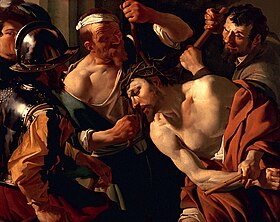Utrecht Caravaggism

Utrecht Caravaggism (
History
Painters such as

Utrecht was the most Catholic city in the

The brief flourishing of Utrecht Caravaggism ended around 1630. At that time, major artists had either died, as in the case of Baburen and ter Brugghen, or had changed style, like Honthorst's shift to portraiture and history scenes informed by the Flemish tendencies associated with Peter Paul Rubens and his followers. They left a legacy through their influence on Rembrandt's use of chiaroscuro and Gerrit Dou's "niche paintings" (a genre developed by Honthorst).
Along with other Caravaggisti active in Italy and Woerden, they set the stage for later artists who worked in a Caravaggio-inspired manner such as Georges de La Tour in Lorraine. They may have also influenced Flemish Caravaggisti such as Theodoor Rombouts, Gerard Seghers, Jan Cossiers, Adam de Coster and Jan Janssens, most of whom had spent time in Italy where they had been influenced first-hand by the same artists who had influenced the Utrecht Caravaggists.[5]
Work
The Utrecht Caravaggisti painted mainly history paintings and genre scenes. They broke with the dominant Northern Mannerism previously in favour in the Dutch Republic, preferring a heightened realism borrowed from Caravaggio. Their works were characterized by a direct and lifelike representation of figures in powerful compositions. They preferred the use of chiaroscuro effects which raised the dramatic impact of their compositions which were filled with a small number of figures which are portrayed in close-up. The saints in their biblical compositions are depicted as ordinary people.[2]
References
- ISBN 0-14-051300-0
- ^ a b Paul Huys Janssen, Utrecht Caravaggisti, at Grove Art Online, accessed on 16 January 2021
- ISBN 0-300-10237-2
- ^ "Matthias Stom, Old Woman Praying". Metropolitan Museum. Retrieved 2020-03-28.
- ^ Gregori, Mina, Luigi Salerno, and Richard E. Spear, The Age of Caravaggio, Metropolitan Museum of Art, 1985
External links
 Media related to Utrecht Caravaggisti at Wikimedia Commons
Media related to Utrecht Caravaggisti at Wikimedia Commons- Orazio and Artemisia Gentileschi, a fully digitized exhibition catalog from The Metropolitan Museum of Art Libraries, which contains material on Utrecht Caravaggism (see index)
- Fifteenth- to eighteenth-century European paintings: France, Central Europe, the Netherlands, Spain, and Great Britain, a collection catalog fully available online as a PDF, which contains material on Utrecht Caravaggism
